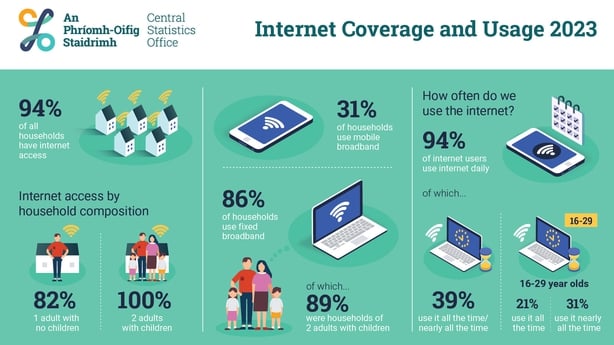New figures from the Central Statistics Office shows that 94% of internet users go online daily, and of these, 39% use it all the time or nearly all the time.
The CSO's Internet Coverage and Usage in Ireland research shows that 92% of people aged 16 years and older were recent users of the internet, which means they had used it within the three months before the survey. This was unchanged from 2022.
Daily internet usage also remained unchanged from when the survey was last carried out in 2022.
The CSO figures show that students were the most frequent users of the internet in 2023 with all students using the internet every day or almost every day.
Of these daily internet users, the CSO said that 99% went online at least several times a day, while 33% used the internet several times a day.
A further 41% of students used the internet nearly all the time, and 24% used the internet all the time, the CSO added.
It also noted that 98% of internet users surveyed and who were living in households with children, used the internet every day or almost every day.
Just 7% of people aged 16 years and older had never used the internet, although this predominantly related to older people where 42% of persons aged 75 and over had never used the internet.
Today's CSO figures show that 94% of households have internet connectivity.

Household internet connectivity was highest for the Dublin region at 96%, compared with the Border and Midland regions at 91% of households. The Border region includes counties Cavan, Donegal, Leitrim, Monaghan, and Sligo, while the Midland region includes counties Laois, Longford, Offaly, and Westmeath.
The CSO said that household internet access was mainly via fixed broadband access (86%), up one percentage point from 2022.
Fixed broadband connection was highest in the Dublin region at 91% of households, compared with the Border region at 79%, it added.
Of households with no internet access, the most common reason given (56%) was that they did not need the internet, followed by lack of skills or knowledge (27%).
6% of these households with no internet access stated that broadband internet was not available in their area.
